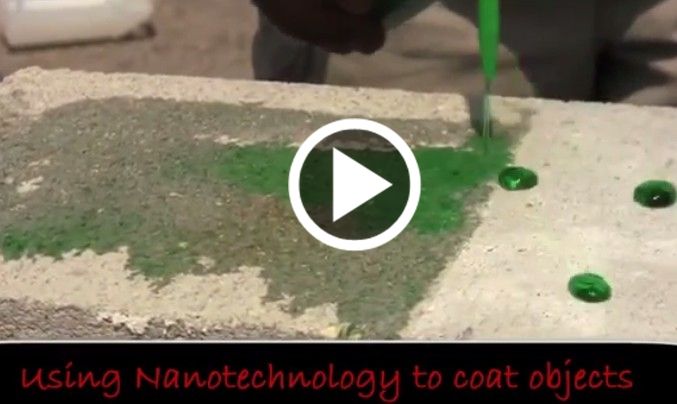We often hear of new technological improvements - robots, gadgets, phones, vehicles, medicine and more.
But these are just part of the picture of scientific achievement. No less important is the field of chemical engineering,
which has invented some amazing materials in recent years, materials that may forever change our lives.
These are 7 of the most fascinating and powerful materials science has come up with in recent years.
1. Aerogel

Aerogel is the proud holder of 15 mentions in the Guinness Book of Records, which is more than any material has ever had.
Also known as the 'frozen smoke', a nickname resulting looking like solid smoke, aerogel is actually 99.8% empty space,
which explains its semi-transparent look. This material is a terrific insulator.
With a shield made from aerogel, you could challenge any flamethrower without danger - it will take it without you feeling a
thing. It does the same with cold. With enough of it, you could build a comfortable house on the moon.
Another amazing factoid - an inch of aerogel could have an internal structure so complex that an inch long piece
could have a surface area as long as football field.
2. Carbon nanotubes

Imagine long chains of carbon, these super-structures are bonded together by the greatest power in all of the chemical world,
the sp2 bond. These carbon nanotubes have been constructed with length-to-diameter ratio of up to 132,000,000:1,
significantly larger than for any other material.
This means they are exceptionally strong, and in fact, may be the only material humanity will be able to use to construct
the 'space elevator' that will cart people and cargo up and down from space stations hovering above the earth.
Carbon nanotubes are 300 times stronger than steel, meaning you could potentially build towers hundreds of kilometers tall
(or thousands of feet).
3. Metamaterials

Metamaterials are artificial materials engineered to have properties that may not be found in nature. They are assemblies of multiple
individual elements fashioned from conventional microscopic materials such as metals or plastics, but the materials are usually
arranged in periodic patterns. Metamaterials gain their properties not from their composition, but from their exactingly-designed
structures. Their precise shape, geometry, size, orientation and arrangement can affect the waves of light or sound in an unconventional
manner, creating material properties which are unachievable with conventional materials.
These metamaterials achieve desired effects by incorporating structural elements of sub-wavelength sizes, i.e. features that are actually
smaller than the wavelength of the waves they affect. The primary research in metamaterials investigates materials with negative
refractive index. Negative refractive index materials appear to permit the creation of super lenses which can have a spatial resolution
below that of the wavelength. In other words - it makes invisibility cloaks.
4. Nano-Diamond

Nanodiamond was convincingly demonstrated to be produced by compression of graphite in 2003 and in the same work found to be much
harder than bulk diamond, which makes it the hardest known material, while also being incredibly strong, light, and made of the most
common element you can find - carbon. It is an amazing heat conductor and has the highest melting point of all materials. Machines built
with this material would be lighter, stronger and more powerful than anything we have today.
5. Amorphous metal

By cooling molten metal quickly before it has time to re-align its particles in a solid shape, we can created amorphous metals -
metals that have a disorganized atomic structure. Due to this structure anomaly, they are twice as strong as steel, and a few
armies are considering using them for shields. In addition to their strength, amorphous metals have improved electricity conductivity
and can improve the efficiency of a power grid by up to 40%, saving a huge amount of energy and the burning of fossil fuels.
6. Transparent Alumina

This material is 3 times as strong as steel, while being transparent. There are so many applications for this that the mind boggles.
Imagine buildings made of transparent, stronger steel. It will reduce visual pollution in the cities. Many structures that stand alone
could be invisible (with just a little opaqueness so we know they are there of course).
7. E-textiles

In about 10 years, you and everyone you know will probably know all about E-textiles. In fact, you'll be covered with them.
Why carry our cell phones around when we can just wear them? Clothes in the future will be embedded with these tiny
E-Textiles (already existing today) that can monitor our health, project videos, make phone calls and bring up information
from the Internet when we need it. The possibilities are endless.
Get Nidokidos Emails | Register at our forum | Facebook | Twitter | Daily Website Update
============================================
Power of Nanotechnology
This Amazing Technology Will Blow Your Mind
Click here to watch this video

http://www.nidokidos.org/threads/224056
Posted by: Murli dhar Gupta <mdguptabpl@gmail.com>
| Reply via web post | • | Reply to sender | • | Reply to group | • | Start a New Topic | • | Messages in this topic (1) |
NidokidoS Group for best of forwarded mails
To join us , send an email to
nidokidos-subscribe@yahoogroups.com
Be the part of Nidokidos , Join our Forum
http://www.nidokidos.org
to share your emails with us, send them at
nidokidos@yahoogroups.com
===================================================
No comments:
Post a Comment